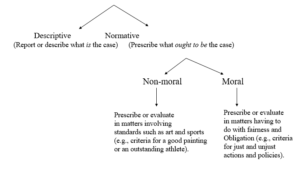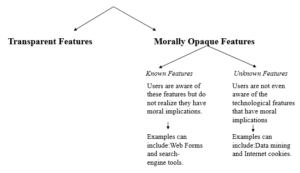Cyberethicss
Uniqueness Issue (Continued)
- Traditionalists and uniqueness proponents are each partly correct.
- Traditionalists correctly point out that no new ethical issues have been introduced by computers.
- Uniqueness proponents are correct in that cybertechnology has complicated our analysis of traditional ethical issues.
- So we must distinguish between: (a) unique technological features, and (b) any (alleged) unique ethical issues.
- Two scenarios from the text:
–(a) Computer professionals designing and coding a controversial computer system
–(b) Software piracy
Case Illustration of a Policy Vacuum: Duplicating Software
- In the early 1980s, there were no clear laws regarding the duplication of software programs, which was made easy because of personal computers.
- A policy vacuum arose.
- Before the policy vacuum could be filled, we had to clear up a conceptual model: What exactly is software?
- Applied ethics, unlike theoretical ethics, examines “practical” ethical issues.
- It analyzes moral issues from the vantage-point of one or more ethical theories.
- Ethicists working in fields of applied ethics are more interested in applying ethical theories to the analysis of specific moral problems than in debating the ethical theories themselves.
- Three distinct perspectives of applied ethics (as applied to cyberethics):
- Professional Ethics
- Philosophical Ethics
- Descriptive Ethics
Perspective # 1: Professional Ethics
- According to this view, cyberethics is the field that identifies and analyzes issues of ethical responsibility for computer professionals.
- Consider a computer professional’s role in designing, developing, and maintaining computer hardware and software systems.
–Suppose a programmer discovers that a software product she has been working on is about to be released for sale to the public, even though it is unreliable because it contains “buggy” software.
–Should she “blow the whistle?”
Professional Ethics
- Don Gotterbarn (1991) argued that all genuine computer ethics issues are professional ethics issues.
- Computer ethics, for Gotterbarn is like medical ethics and legal ethics, which are tied to issues involving specific professions.
- He notes that computer ethics issues aren’t about technology – e.g., we don’t have automobile ethics, airplane ethics, etc.
Criticism of Professional Ethics Perspective
- Gotterbarn’s model for computer ethics seems too narrow for cyberethics.
- Cyberethics issues affect not only computer professionals; they effect everyone.
- Before the widespread use of the Internet, Gotterbarn’s professional-ethics model may have been adequate.
Perspective # 2: Philosophical Ethics
- From this perspective, cyberethics is a field of philosophical analysis and inquiry that goes beyond professional ethics (Gotterbarn).
- Moor (1985), defines computer ethics as:
–…the analysis of the nature and social impact of computer technology and the corresponding formulation and justification of policies for the ethical use of such technology. [Italics Added.]
Philosophical Ethics Perspective (continued)
- Moor argues that automobile and airplane technologies did not affect our social policies and norms in the same kinds of fundamental ways that computer technology has.
- Automobile and airplane technologies have revolutionized transportation, resulting in our ability to travel faster and farther than was possible in previous eras.
- But they did not have the same impact on our legal and moral systems as cybertechnology.
Philosophical Ethics: Standard Model of Applied Ethics
- Philip Brey (2000) describes the “standard methodology” used by philosophers in applied ethics research as having three stages:
- 1)Identify a particular controversial practice as a moral problem.
- 2)Describe and analyze the problem by clarifying concepts and examining the factual data associated with that problem.
- 3)Apply moral theories and principles to reach a position about the particular moral issue.
Perspective #3: Cyberethics as a Field of Descriptive Ethics
- The professional and philosophical perspectives both illustrate normative inquiries into applied ethics issues.
- Normative inquiries or studies are contrasted with descriptive studies.
- Descriptive investigations report about “what is the case“; normative inquiries evaluate situations from the vantage-point of the question: “what ought to be the case.”
Descriptive Ethics Perspective (continued)
- Scenario: A community’s workforce and the introduction of a new technology.
- Suppose a new technology displaces 8,000 workers in a community.
- If we analyze the issues solely in terms of the number of jobs that were gained or lost in that community, our investigation is essentially descriptive in nature.
- We are simply describing an impact that technology X has for Community Y.
-
- Descriptive vs. Normative Claims
- Consider three assertions:
–(1) “Bill Gates served as the Chief Executive Officer of Microsoft Corporation for many years.”
–(2) “Bill Gates should expand Microsoft’s product offerings.“
–(3) “Bill Gates should not engage in business practices that are unfair to competitors.”
- Claims (2) And (3) are normative, (1) is descriptive; (2) is normative but nonmoral, while (3) is both normative and moral.
Figure 1-1: Descriptive vs. Normative Claims

Some Benefits of Using the Descriptive Approach
- Huff & Finholt (1994) claim that when we understand the descriptive aspect of social effects of technology, the normative ethical issues become clearer.
- The descriptive perspective prepare us for our subsequent analysis of ethical issues that affect our system of policies and laws.
Table 1-2: Summary of Cyberethics Perspectives
| Type of Perspective | Associated Disciplines | Issues Examined |
| Professional | Computer Science
Engineering Library/Information Science |
Professional Responsibility
System Reliability/Safety Codes of Conduct |
| Philosophical | Philosophy
Law |
Privacy & Anonymity
Intellectual Property Free Speech |
| Descriptive | Sociology
Behavioral Sciences |
Impact of cybertechnology on governmental/financial/ educational institutions and socio-demographic groups |
Is Cyber-technology Neutral?
- Technology seems neutral, at least initially.
- Consider the cliché: “Guns don’t kill people, people kill people.”
- Corlann Gee Bush (19997) argues that gun technology, like all technologies, is biased in certain directions.
- She points out that certain features inherent in gun technology itself cause guns to be biased in a direction towards violence.
A “Disclosive” Method for Cyberethics
- Brey (2001) believes that because of embedded biases in cybertechnology, the standard applied-ethics methodology is not adequate for identifying cyberethics issues.
- We might fail to notice certain features embedded in the design of cybertechnology.
- Using the standard model, we might also fail to recognize that certain practices involving cybertechnology can have moral implications.
- Brey notes that one weakness of the “standard method of applied ethics” is that it tends to focus on known moral controversies
- So that model fails to identify those practices involving cybertechnology which have moral implications but that are not yet known.
- Brey refers to these practices as having morally opaque (or morally non-transparent) features, which he contrasts with “morally transparent” features.
Figure 1-2 Embedded Technological Features Having Moral Implications

A Multi-Disciplinary & Multi-Level Method for Cyberethics
- Brey’s “disclosive method” is multidisciplinary because it requires the collaboration of computer scientists, philosophers, and social scientists.
- It also is multi-level because the method for conducting computer ethics research requires the following three levels of analysis:
–disclosure level
–theoretical level
–application level.
Table 1-3: Three Levels in Brey’s “Disclosive Model”
Level Disciplines Involved Task/Function
| Disclosive | Computer Science
Social Science (optional) |
Disclose embedded features in computer technology that have moral import |
| Theoretical | Philosophy | Test newly disclosed features against standard ethical theories |
| Application | Computer Science
Philosophy Social Science |
Apply standard or newly revised/ formulated ethical theories to the issues
|
Three-step Strategy for Approaching Cyberethics Issues


